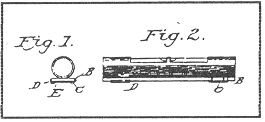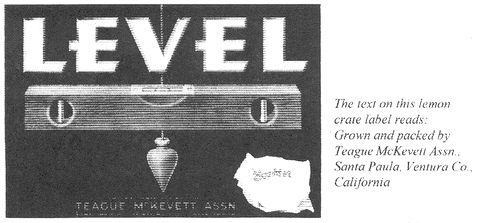This article covers fifteen patents granted to Californians from 1862 to 1898.
Patent Date: 1862 Patent No: 36,906
Inventor: Thomas N. Hosmer
Invention: Spirit
Level
City: Todd's Valley
This early California patent concerned adjustments for both the plumb and level vial setups. Stanley collectors and level collectors will recognize this patent as being found on Type 4 Stanley levels. Stanley used only the single screw adjustment feature shown on the main horizontal level vial. 1t is interesting to note that the patent was 10 years old before it appeared on a Stanley level. Does anyone know of an earlier use, or different application, of this patent?
Patent Date: 1868 Patent No: 78,391
Inventor: Herman Schussler
Invention: Chain Inclinometer
City: San Francisco
This invention of a surveyor's chain inclinometer looks familiar but I can't recall this specific instrument. As with many of the early patents, the invention looks practical and simple.
Patent Date 1881 Patent No: 236,282
Inventor: Walter W. Vaughn
Invention: Reflector for Spirit Levels
City: Stockton
Vaughn's level incorporates several features that are not obvious upon inspecting the patent drawing. The invention encompasses the use of adjustable mirrors appropriately positioned for each vial. This is not the first level to incorporate reflectors, but I haven't determined what the differences are between the various reflectors. The dotted lines along the length of the base of the level indicate a storage place for the rod (G) when not in use, When in use, it screws into the center of the end stock of the level and provides a means to push the level into places that the user could not otherwise reach. These are called extensible levels and there are also many variations on this theme. I have not checked to see which was first. On this version, the position of the bubble could be read from a distance using the mirrors. I am not aware of any other level whereon the two features are so complimentary.

Patent Date: 1887 Patent No: 359,236
Inventor: William R. Vogt
Invention: Spirit Level
City: Oakland
This is a patent for a level with push up sights and a swivel plate on the bottom of the level to allow it to be positioned on a post. These sights are typical of the time period; one end was a plate with a pinhole and when fully extended, the pinhole would be exactly opposite the top of the plate on the opposite end. Earlier sighting levels of this type did not use cross hair(s) opposite the pin hole. Patents of sights by Woods and Pickering both employed cross hairs (wires). The sights, once elevated from the end plates, were held in position by springs placed on the top of the stock. The general arrangement of sights is relatively common in craftsman-made or adapted level sights of the time period. However, the spring arrangement appears to be novel in that other patented sights employed extended springs to hold the sight in position, while this arrangement must use a compressed spring. 1 am particularly anxious to find a copy of this level because of an interest I have in sighting levels and their development.
Patent Date: 1897 Patent No: 363,491
Inventor: B.F. Van Amringe
Invention: Combined Bevel Square, Beam Compass, Level and Gage
City: Oakland
The combination tool of Van Amringe is known to most tool collectors. it is one of the most interesting and collectable of combination tools and combines not only the features declared in the title (bevel square, beam compass, level and gage) but also a saw and rule. Next to the Hosmer patent, the Van Amringe is the next best known of the California level patents covered in this article.
Patent Date: 1887 Patent No: 373,715
Inventor: Thomas H. Bates
Invention: Combined Scale Measure and Spirit Level
City: Pasadena
This patent for a "Combined Scale Measure and Spirit Level" is the first of three 19th century California patents for rules containing one or more level vials. The other two were granted to John Barrie of Los Angeles in 1897. The unique feature of the Bates patent was a sliding cover for the vial that was set flush with the face of the rule.

Patent Date: 1892 Patent No: 479,521

Inventor: Ernest McCullough
Invention: Spirit Level for Measuring Tapes
City: San Francisco
Ernest McCullough's invention of a spirit level (see patent illustration above) that could be attached to measuring tapes is one of those things that seems, like the line level, almost too simple to be patentable. Does anyone have one of these levels? It consists of a metal case with two spring clips on the bottom to hold it to the tape.
Patent Date: 1893 Patent No: 498,084
Inventor: Lee Rogers
Invention: Plumb Level
City: Pomona
This invention concerns the earliest California patent for a self-indicating inclinometer. The entire central part of the of the apparatus was designed to be removable if desired. Adjustment of the pointer was to be accomplished by removing a portion of the top plate (right hand side in Figure 1) and turning the cog wheel with any slim strip of wood or metal. This is properly called a weighted needle type of inclinometer.
Patent Date: 1893 Patent No. 506,934
Inventor: John Petitt
Invention: Plumb Level
City: San Diego
John Petitt followed the Rogers invention by a few months thus becoming the second California patent for a self-indicating inclinometer. This invention carries a weight suspended from a shaft through the center of the indicating needles. The patent envisioned that the arbor shaft would be suspended between studs projecting through the glass on each side of the level. At least one of these tools is kno~'ll and is in the possession of a West Coast collector. The level was manufactured in San Francisco.
Patent Date: 1896 Patent No. 566,555
Inventor: John Appleton
Invention: Plumb Level
City: Modesto
This patent might be classified as an indicating pendulum type of inclinometer. There is a pointer of some type set into the pendulum and extending through the slot in the face plate (K in the patent drawing). Movement of the pendulum is damped by a spring arrangement above the upper part of the indicating device (N in the patent drawing). I seem to remember seeing this level somewhere.

Patent date: 1897 Patent No: 577,708
Inventor: J. D. Barrie
Invention: Parallel Ruler
City: Los Angeles
Barrie's first patent was for a parallel ruler with attached plumb and level capabilities. This is one of "them thar magic twanger type tools". The inventor envisioned the tool for use with a blackboard. The dotted line on top of the tool in Figure 1 of the drawing, is an elastic cord which could be chalked and then used to snap (twang) a chalked line on the adjacent surface. The eight circles that show in Figure 2 are soft cushion feet to prevent the rule from slipping when pressed against a black board. This tool also contains a groove lined with sandpaper for sharpening chalk or a pencil. The inventor also realized that the user might not want spirit vials and thus included (Figure 8) the concept of a plumb bob used against a circle with graduations. The parallel rule concept comes from the two extension pieces that hold the chalk line. The extension pieces are graduated and may be set at varying distances parallel to the main frame.
Patent Date: 1897 Patent No: 585,653
Inventor: Edward T. Clowe
Invention: Carpenter's Level
City: Woodland
This invention is one of the simplest imaginable. It consists of two inclined slots and/or two slots straight through the body such that a mirror can be inserted into them; and, a metal strip to hold in the mirror. This was envisioned as being applicable to any level and could be used as much as 12 feet overhead. Imagine trying to patent that today.
Patent Date: 1897 Patent No. 591,804
Inventor: J. D. Barrie
Invention: Desk Ruler
City: Los Angeles
Barrie's second patent, for a desk ruler, incorporated an elastic pencil
holder and a mean looking little pencil sharpener in addition to the level.


Patent Date: 1898 Patent No: 600,396
Inventor: Charles Warren
Invention: Plumb Level
City: Rough and Ready
Rough and Ready is a real town in California, and is located between the towns of You Bet and Timbuctoo. Warren's device combines a compass, an inclinometer, and curved sights. All are contained in a compact pocket device. In Figure I of the patent drawing, the sights are shown in an open position by dotted lines. The cover glass is hinged at the bottom for easy access to the face of the dial. 1 would like to locate this level.
Patent Date: 1898 Patent No: 604,985
Inventor: John Hartford
Invention: Spirit Level
City: San Francisco
Hartford's invention contained what was essentially a double bevel; wherein
each bevel had a 90 degree lock. The center of the device was a circular tube
containing the alcohol. Apparently there were no graduations envisioned but the
4-armed clamp in the center of the device could be rotated such that a
measurement could be locked in and carried to another location. The top of the
frame was ruled. I suspect that this device may have been produced in some
quantity, however small, because I do have a level that incorporates some of
these features. To me, this means that my level is a copycat attempt for this
patent or vice versa.
